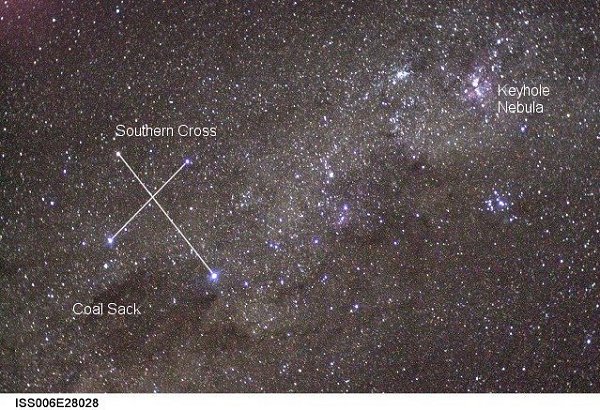β Crucis: Mimosa
Chandra grating spectroscopy

β Cru, or Mimosa, is the bright star marking the left arm of the Southern Cross (Crux), seen in the image above, and also in the flag of New Zealand, below.

β Cru is a hot star, classified as B0.5 III (with an effective temperature slightly less than 30,000 K, five times hotter than the Sun). It has a radiation-driven stellar wind, but one that is significantly weaker than those seen on O stars, like ζ Pup. Already known to have relatively strong soft X-ray emission, β Cru was observed by us with the HETGS aboard Chandra. Our goal was to apply the standard hot star wind plasma X-ray diagnostics to this weak-wind hot star: line width analysis for kinematics of the X-ray emitting plasma, line ratios for spatial distribution with respect to the photosphere, overall spectral energy distribution for insight into the temperature distribution in the hot plasma. All these diagnostics, as well as time-variability analysis, can be used to test the applicability of the wind-shock scenario that seems to apply to the very hottest O stars to the somewhat cooler early B stars.
We are still completing our analysis, but have some prelimary results: The grating spectrum is very soft, the emission lines are narrow (though not completely unresolved), and the plasma looks to be close to the photosphere. However, one surprising result of our observation was the discovery of a previously unknown binary companion just 4 arcseconds from β Cru. Here is the center of the ACIS detector, showing the zeroth order spectrum of the primary, β Cru, as well as the zeroth order spectrum of this newly discovered companion:

The gray circles reprsent the centroids of the two sources, and the straight lines are the associated extraction regions for the dispersed spectra. The figure shows a third "source" where we sampled the sky background.
Note that the secondary has never been seen in optical images because the primary is so bright (and thus the secondary must be quite dim, like a late-type companion would be).
It can be seen in the above image that we can separate the two components - both their zeroth order spectra and, because of the fortuitous roll angle, their dispersed spectra. The spectrum of the primary is very soft, as we mentioned above and as is seen for other hot stars, whereas the spectrum of the seconary is much harder. Here are the two ACIS zeroth order spectra (primary on left, secondary on right):


The spectrum of the secondary is clearly much harder. Although the secondary's optical brightness must be very much smaller than the primary's, its X-ray brightness is only about a factor of ten less than the primary's - it's X-ray to optical brightness ratio is quite high. This, as well as the observed hard spectrum, is just what would be exptected from a pre-main-sequence star. And in fact, ROSAT discovered a small stellar nursery (six PMS stars) in the vicinity of β Cru. So, this newly discovered companion could very likely be part of that population.
PMS stars often show X-ray variability, so we have examined the time variability properties of both components. Here are the respective light curves (primary on left, secondary on right):


The secondary is variable, but the primary is not.
We are currently analyzing the dispersed spectra, and will have results posted here soon. Here is a priliminary plot, overlaying the two component's MEG spectra:

We will have a manuscript posted here shortly.
Here is the final report we submitted for this project to the Chandra X-ray Center, in June 2004 [reporting form | description of science results]







